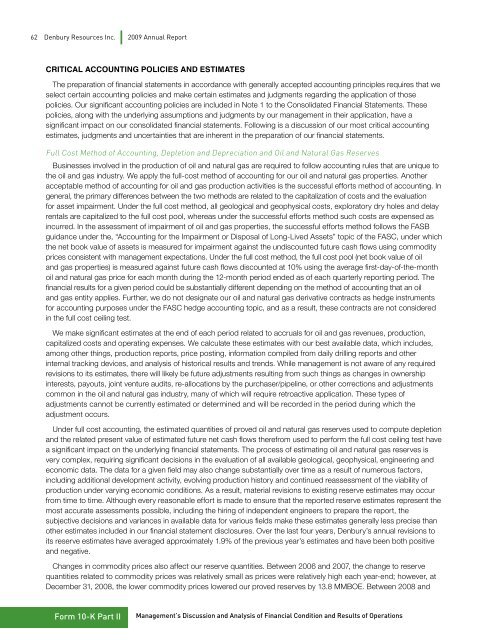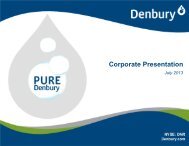Interactive 2009 Annual Report (PDF 7.56 MB) - Denbury Resources ...
Interactive 2009 Annual Report (PDF 7.56 MB) - Denbury Resources ...
Interactive 2009 Annual Report (PDF 7.56 MB) - Denbury Resources ...
- No tags were found...
You also want an ePaper? Increase the reach of your titles
YUMPU automatically turns print PDFs into web optimized ePapers that Google loves.
62 <strong>Denbury</strong> <strong>Resources</strong> Inc. <strong>2009</strong> <strong>Annual</strong> <strong>Report</strong>Critical Accounting Policies and EstimatesThe preparation of financial statements in accordance with generally accepted accounting principles requires that weselect certain accounting policies and make certain estimates and judgments regarding the application of thosepolicies. Our significant accounting policies are included in Note 1 to the Consolidated Financial Statements. Thesepolicies, along with the underlying assumptions and judgments by our management in their application, have asignificant impact on our consolidated financial statements. Following is a discussion of our most critical accountingestimates, judgments and uncertainties that are inherent in the preparation of our financial statements.Full Cost Method of Accounting, Depletion and Depreciation and Oil and Natural Gas ReservesBusinesses involved in the production of oil and natural gas are required to follow accounting rules that are unique tothe oil and gas industry. We apply the full-cost method of accounting for our oil and natural gas properties. Anotheracceptable method of accounting for oil and gas production activities is the successful efforts method of accounting. Ingeneral, the primary differences between the two methods are related to the capitalization of costs and the evaluationfor asset impairment. Under the full cost method, all geological and geophysical costs, exploratory dry holes and delayrentals are capitalized to the full cost pool, whereas under the successful efforts method such costs are expensed asincurred. In the assessment of impairment of oil and gas properties, the successful efforts method follows the FASBguidance under the, “Accounting for the Impairment or Disposal of Long-Lived Assets” topic of the FASC, under whichthe net book value of assets is measured for impairment against the undiscounted future cash flows using commodityprices consistent with management expectations. Under the full cost method, the full cost pool (net book value of oiland gas properties) is measured against future cash flows discounted at 10% using the average first-day-of-the-monthoil and natural gas price for each month during the 12-month period ended as of each quarterly reporting period. Thefinancial results for a given period could be substantially different depending on the method of accounting that an oiland gas entity applies. Further, we do not designate our oil and natural gas derivative contracts as hedge instrumentsfor accounting purposes under the FASC hedge accounting topic, and as a result, these contracts are not consideredin the full cost ceiling test.We make significant estimates at the end of each period related to accruals for oil and gas revenues, production,capitalized costs and operating expenses. We calculate these estimates with our best available data, which includes,among other things, production reports, price posting, information compiled from daily drilling reports and otherinternal tracking devices, and analysis of historical results and trends. While management is not aware of any requiredrevisions to its estimates, there will likely be future adjustments resulting from such things as changes in ownershipinterests, payouts, joint venture audits, re-allocations by the purchaser/pipeline, or other corrections and adjustmentscommon in the oil and natural gas industry, many of which will require retroactive application. These types ofadjustments cannot be currently estimated or determined and will be recorded in the period during which theadjustment occurs.Under full cost accounting, the estimated quantities of proved oil and natural gas reserves used to compute depletionand the related present value of estimated future net cash flows therefrom used to perform the full cost ceiling test havea significant impact on the underlying financial statements. The process of estimating oil and natural gas reserves isvery complex, requiring significant decisions in the evaluation of all available geological, geophysical, engineering andeconomic data. The data for a given field may also change substantially over time as a result of numerous factors,including additional development activity, evolving production history and continued reassessment of the viability ofproduction under varying economic conditions. As a result, material revisions to existing reserve estimates may occurfrom time to time. Although every reasonable effort is made to ensure that the reported reserve estimates represent themost accurate assessments possible, including the hiring of independent engineers to prepare the report, thesubjective decisions and variances in available data for various fields make these estimates generally less precise thanother estimates included in our financial statement disclosures. Over the last four years, <strong>Denbury</strong>’s annual revisions toits reserve estimates have averaged approximately 1.9% of the previous year’s estimates and have been both positiveand negative.Changes in commodity prices also affect our reserve quantities. Between 2006 and 2007, the change to reservequantities related to commodity prices was relatively small as prices were relatively high each year-end; however, atDecember 31, 2008, the lower commodity prices lowered our proved reserves by 13.8 M<strong>MB</strong>OE. Between 2008 andForm 10-K Part IIManagement’s Discussion and Analysis of Financial Condition and Results of Operations




